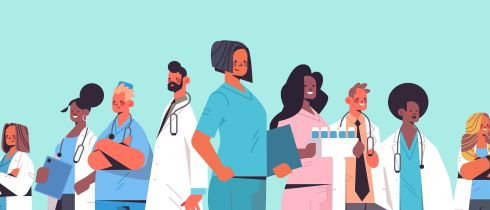Tackling inequalities in research

The recent pandemic highlighted how clinical research excludes or overlooks the people most affected by the virus – exacerbating their mistrust in science
12th December 2022
Professor Winston Morgan FRSB is director of Impact and Innovation at the University of East London’s School of Health, Sport and Bioscience
It is an uncomfortable truth that society has learned to live with inequalities based on race or ethnicity in social, educational and economic outcomes for as long as data has been available. However, there was widespread bewilderment when in 2020 the UK’s Office for National Statistics reported new data showing disproportionate rates of COVID-19 infections and deaths linked to race, with similar patterns in the US.
In the absence of any relevant clinical research to reassure those most affected, for over a year various theories were proposed about susceptibility to the virus, including the role of Neanderthal genes and a person’s blood type – none of which fitted with the pattern of those affected by the virus. When society turned to the clinicians and scientists for answers, they were unable (or unwilling) to use research to explain that this was not about genes, but social and structural factors.
These failures and uncertainties were a direct consequence of years of inequalities in clinical research practices at different levels, including those doing the research, the subjects recruited to participate and the proportion of resources directed towards certain types of clinical research. The pandemic highlighted a distinct lack of researchers coming from certain backgrounds, particularly those described as Black and in senior positions. These uncertainties, driven by inequalities, had direct real-world consequences.
The underrepresented communities affected understandably feared that if there were deficiencies in the scientific knowledge about why this virus affected them disproportionately, perhaps the vaccine, which was developed relatively quickly, might also have disproportionate adverse effects on them. To compound matters the groups most affected by the virus were significantly underrepresented in the initial clinical trials for the vaccine.
Counter misinformation
Without a critical mass of senior researchers from these communities with access to the relevant clinical research providing credible counter-narratives to the misinformation around the vaccine to their communities, long-lasting damage to vaccine uptake has been recorded in these communities. These inequalities are a major driver of what was described as vaccine hesitancy.
These issues are just the latest example of long-standing health inequalities that could be resolved with greater equity in clinical research. Some of the most obvious examples include many areas of women’s health, pregnancy, infant mortality and perceptions of pain in Black people. In all these areas there is an intersection with socioeconomic class and race that compounds the inequality, but also helps disguise the role of simple racial discrimination.
 "Clinical researchers do not appear by magic - it takes many years of training and planning to produce a clinical researcher and to ensure there is equity in the type of research undertaken," writes Morgan.
"Clinical researchers do not appear by magic - it takes many years of training and planning to produce a clinical researcher and to ensure there is equity in the type of research undertaken," writes Morgan. Social determinants
These are clear reminders of the importance of the social determinants of health. The root of poorer medical outcomes is not always the result of inequalities in clinical research or researchers, but in the attitudes and structures of the society in which they operate.
The infamous 1930s Tuskegee experiment was started and went on far too long, not because the medical community needed to know how to treat syphilis in Black people, which they knew was exactly the same as how it is treated in white people, but so that the scientists could learn the consequences of allowing the disease to run its “natural” course. The isolated Black population of Tuskegee was both expedient and expendable. With greater equity in staffing structure at all levels such an experiment would not have lasted for more than 30 years.
Similarly, the higher levels of maternal and infant mortality in certain communities cannot always be attributed to the lack of scientific knowledge from clinical research on what causes these higher rates of death – we know these deaths are more likely to be the result of social rather than biological factors. Sadly, in the absence of appropriate clinical research we can continue to blame biology linked to race rather than social factors linked to racism.
The US and UK, the two countries that lead the world in many areas of clinical research on COVID-19 and vaccine development have significantly racially diverse populations. So why have so few talented individuals from these communities, particularly Black communities, been involved in clinical research, as participants or as researchers in senior roles and therefore in a position to advise government agencies and the public on health and clinical issues?
The answer lies in the obstacles to clinical research for people in underrepresented groups. The process starts with the pipeline into university from schools, degree outcomes at university and, once employed, the lack of career progression and promotion. Why are we surprised, given the many everyday micro-aggressions most Black people will acknowledge they suffer?
In terms of inspiration, there is a significant underrepresentation of Black academics and professors, and there has never been a Black Nobel laureate in a STEM subject. When teachers and other gatekeepers cannot imagine a Black clinical scientist, they find it difficult to offer Black pupils the option of studying science at university. Students from underrepresented groups still enter universities in vast numbers, but at university stereotypes are reinforced by the lack of Black academics, particularly professors. In this environment fewer students gain a positive experience of research as a career or are awarded the higher degree classifications that enable them to progress into research posts.
In the same way, the inequalities we see in women’s health can be traced back to the fact that science and medicine was not always a welcoming place for women. Few reached positions where they could influence who did the research and what was being researched, leaving wide gaps even today in our knowledge of conditions that affect at least half the population.
Changing attitudes
Progress only began following changes in attitudes and policies, driven by initiatives such as Athena Swan. Similar initiatives are needed for other underrepresented groups. Clinical researchers do not appear by magic – it takes many years of training and planning to produce a clinical researcher and to ensure there is equity in the type of research undertaken.
Health inequalities can be reduced with greater equity and diversity in clinical research, but most of the challenges highlighted by the COVID-19 pandemic will only be solved with wider societal change.
Professor Morgan recently chaired an RSB Policy Lates event on reducing inequalities in clinical research, a video of which can be watched here.


